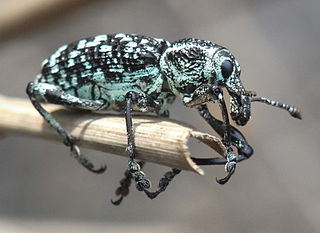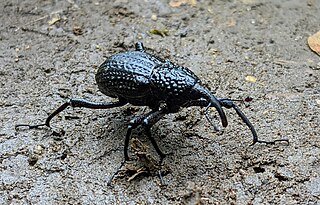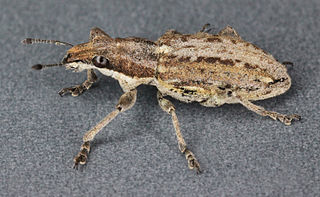
Equisetum is the only living genus in Equisetaceae, a family of vascular plants that reproduce by spores rather than seeds.

Chrysolopus spectabilis is a species of weevil found in south-eastern Australia. It was discovered during James Cook's first voyage, and became one of the first insects to be described from Australia. The weevil measures up to 25 mm (1.0 in) long and includes distinctive metallic green and black scales. It is found only on 28 species of the plant genus Acacia.

Equisetum arvense, the field horsetail or common horsetail, is an herbaceous perennial plant in the Equisetidae (horsetails) sub-class, native throughout the arctic and temperate regions of the Northern Hemisphere. It has separate sterile non-reproductive and fertile spore-bearing stems growing from a perennial underground rhizomatous stem system. The fertile stems are produced in early spring and are non-photosynthetic, while the green sterile stems start to grow after the fertile stems have wilted and persist through the summer until the first autumn frosts. It is sometimes confused with mare's tail, Hippuris vulgaris.

Curculio is a genus of weevils belonging the family Curculionidae and subfamily Curculioninae. Members of the genus are commonly referred to as acorn weevils or nut weevils as they infest the seeds of trees such as oaks and hickories. The adult female weevil bores a tiny hole in the immature nut to lay her eggs, which then hatch into legless grubs. In autumn, the grubs bore holes through the shells from the inside to emerge into the soil where they may live for a year or two before maturing into adults.

Larinus is a genus of true weevils, comprising about 180 species, mostly in the Palaearctic region with some species introduced to North America. Turkey appears to have a significant diversity of the group, with more than 50 species recorded in the eastern part of the country.

Equisetum hyemale is an evergreen perennial herbaceous pteridophyte in the horsetail family Equisetaceae. It is native to Eurasia and Greenland.

Equisetum scirpoides Michx., Fl. Bor.-Amer. 2: 281 (1803). 2 n = 216.The smallest of the currently occurring representatives of the genus Equisetum (horsetail).

Lixus is a genus of true weevils in the beetle family Curculionidae, raised by the Danish entomologist, Johan Christian Fabricius in 1775. There are at least 950 described species in Lixus.

Sipalinus gigas is a species of beetles belonging to the family Curculionidae.

Sternochetus mangiferae is a weevil commonly known as the mango seed weevil, mango stone weevil, or mango weevil. It is a compact weevil typical of the Cryptorhynchinae. It was first described in 1775 in the genus Curculio. The adults are 7.5-9.5 mm long and 4 mm in width.

Barynotus obscurus is a species of weevil native to Europe.

Sitona griseus is a species of weevil native to Europe.

Dryocoetes villosus is a species of weevil native to Europe.

Orthotomicus laricis, commonly known as the lesser larch bark beetle, is a species of weevil native to Europe.

Tournotaris bimaculatus is a species of weevil native to Europe.

Hadroplontus is a genus of minute seed weevils in the family of beetles known as Curculionidae. There are at least two described species in Hadroplontus.

Grypus is a genus of marsh weevils in the beetle family Brachyceridae. There are about 10 described species in Grypus.
Joint grass may refer to:

















